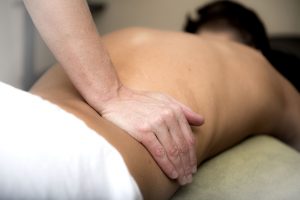Muscle Strains
A strain, sometimes referred to as a pulled muscle, is a muscle injury produced by excessive tensile stress that causes fibers to tear within the tissue. A muscle strain does not usually result from excess stretch alone, but from a combination of tension and contraction.
Muscle strains can develop when excess tension is placed on a muscle while it’s also in contraction. Due to muscle mechanics, strains are more likely while the muscle is in eccentric contraction than concentric or isometric.1,2
There are three grades of muscle strain: first degree or mild, second degree or moderate, and third degree or severe. In a first-degree strain, few muscle fibers are torn. While there might be some post-injury soreness, the individual usually returns to normal levels of activity quickly. With second-degree strains, more fibers are involved in the injury. There is a greater level of pain with this injury and a clear region of maximum tenderness in the muscle tissue.
A complete rupture of the muscle-tendon unit occurs with a grade-three strain. Some strains are classified as third degree even though the muscle still has some fibers intact because the damage is extensive. There is likely significant pain at the time of the injury. Pain can be minimal afterwards, because the ends of the muscle are separated and limb movement does not cause additional tensile stress.
Third-degree strains generally require surgical repair. In some instances, surgery is not performed because the muscle does not play a crucial role and the potential dangers of surgery outweigh the benefits. Ruptures to the rectus femoris are an example because the other three quadriceps muscles make up for the strength deficit caused by the strain.
The muscles most susceptible to strain injuries are multi-articulate muscles, which are those that cross more than one joint. The more joints crossed by a muscle, the greater is their vulnerability for strain injury. All involved joints cannot achieve full range of motion at the same time due to limited extensibility of the muscle tendon unit. If the muscle is stretched across multiple joints at the same time, it’s more susceptible to tearing from excess tensile stress.
Strains can develop in any part of the muscle, but usually occur at the musculotendinous junction.3 The junction of muscle and tendon places one tissue with higher pliability (muscle) directly adjacent to another with limited pliability and more tensile strength (tendon). As a consequence, the point of interface between the two tissues becomes a site of mechanical weakness where the strain occurs.
Muscle strains generally arise from acute injuries. However, there might be repetitive tensile forces on the muscle that cause small degrees of fiber tearing, producing a chronic strain. In most cases, the client can recall a specific movement or accident that produced the strain. Swelling might occur in the area immediately after the injury, but is likely to subside after the initial inflammatory phase (an estimated 72 hours).
Strains, both acute and chronic, are increasingly common where they have previously occurred. Scar tissue that repaired the original strain is a weak point in the muscle’s continuity, and therefore a location vulnerable to re-injury. It’s important to find out whether the client has suffered a previous injury to the area.
Following a strain, resting from offending activities for several weeks provides the body time to heal damaged tissue. Another primary goal of treatment is tension reduction in the affected muscle. Tension is reduced with massage techniques such as effleurage, stripping, broad cross-fiber sweeping, etc. In addition, it’s important to help develop a functional scar at the site of tearing and prevent scar tissue from adversely binding adjacent fibers. Deep transverse friction massage is used to develop a healthy, functional scar. Muscle strains are a common soft-tissue injury and massage is an excellent treatment option to help in the management of these conditions.
References
- Faulkner JA, Brooks SV, Opiteck JA. Injury to skeletal muscle fibers during contractions: conditions of occurrence and prevention. Phys Ther. 1993;73(12):911-921.
- Hoskins W, Pollard H. The management of hamstring injury-Part 1: Issues in diagnosis. Man Ther. May 2005;10(2):96-107.
- Garrett WE, Jr., Safran MR, Seaber AV, Glisson RR, Ribbeck BM. Biomechanical comparison of stimulated and nonstimulated skeletal muscle pulled to failure. Am J Sports Med. 1987;15(5):448-454.
Ready to #feelbetter?
You're just a click away from a wicked good massage!
-

60 Minute Massage Gift Card
$170.00 Add to cart -

90 Minute Massage Gift Card
$255.00 Add to cart -

Mini Aer Small Room Air Purifier
$149.00 Add to cart -
Sale!

Thera-Pearl Sports Pack/Hot Cold
Original price was: $14.99.$12.99Current price is: $12.99. Add to cart -

3 Somadome Sessions Gift Card
$135.00 Add to cart -

20 Minute Somadome Gift Card
$45.00 Add to cart -
Sale!

TheraBand® Stretch Strap
Original price was: $19.99.$14.99Current price is: $14.99. Add to cart -

TheraBand CLX Connective Loop
$14.99 Select options
Energy Boosters
Energy Boosters Ways to Get You Through the Day No amount of coaxing, pleading, or pedal pumping could get the engine in the rental car to turn over. It was going nowhere. The travelers had filled the car with unleaded fuel, but it had a diesel engine. It had been able to run a little…
Read MoreWhat is Qi?
What is Qi? A fundamental concept of traditional Chinese medicine (TCM) dating back over 3,000 years, qi (pronounced “chee”) is the Chinese word for energy, which also carries with it connotations of “air,” “breath,” and “life force.” In TCM, it is understood that everything from humans and animals to rocks and trees is filled with…
Read MoreWhy Buy Organic?
Why Buy Organic? Is the Higher Price Worth It? While shopping in your grocery store’s produce section, you may notice the organically grown apples are pocked and not as big and perfectly round as the conventional produce, but they are more expensive. What’s the difference, and which do you choose? Your decision may significantly impact…
Read MoreAre You Making the Most of Your Massage?
Are You Making the Most of Your Massage? How to Prolong the Benefits of Bodywork A massage works in wonderful ways, easing stress and pain, calming the nervous system, increasing circulation, loosening tight muscles, stimulating internal organs, and enhancing skin. The multiplicity of physiological responses sends a simple, clear message to the mind: Massage feels…
Read MoreThe Case for Chocolate
The Case for Chocolate New Studies Show Health Benefits It’s not like we need a specific reason to eat chocolate, but it doesn’t hurt that studies are finding increasing health benefits associated with the popular indulgence. While chocolate is high in sugar and saturated fat, it does contain chemical compounds with proven benefits, so enjoy–in…
Read MoreThe Wonders of Water
The Wonders of Water For Skin Health and More Shelley Burns, N.D. Creams, nutritional supplements, treatments, lotions, and potions. We are always looking for the next miracle product to keep skin looking healthy and young. However, there is one essential, inexpensive, and often overlooked nutrient right at your fingertips:water. Just as a car cannot function…
Read MoreInvest In Your Health
Invest in Your Health Massage Offers Excellent Return onInvestment “Invest for the long term” is great financial advice, but it’s also great healthcare advice. Never is investing for the long term more important than when you are making day-to-day decisions about your health. There are short-term gains from taking care of your health, to be…
Read MoreLife Hack: Iced Cubes
Life Hack: Coffee Cubes (Redux) As usual in New England, we have gone from Winter to Summer, with Spring being an absentee season (again). Since it feels like Summer is already here, I thought it best to give you a Life Hack that is an oldy, but a goody! Iced Coffee…..CUBES! #mindblown Yes. I have offered this…
Read MoreMake a Great Save to Avoid Back Pain
Make a Great Save to Avoid Back Pain 7- Stretches in 7-Minutes I was speaking the other day with one of our therapists and we were discussing our role in helping our patients. I was explaining that a comment I often tell new patients is; “These are hands, not magic wands”. Patients often seek out…
Read MoreTime for Sleep
Time for Sleep As a nation, we may be divided, but there is one common bond that unites us all around the world; sleep. We all need sleep in order to be capable of performing every day tasks. Sleep is an imperative part of the human experience. Without a good night’s sleep, our bodies will slowly…
Read More









